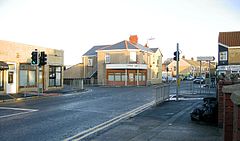Loughor(/ˈlʌxər/;[1]Welsh:Casllwchwr) is atowninSwansea,Wales.HistoricallyinGlamorgan,it lies on theestuaryof theRiver Loughor(Welsh:Afon Llwchwr). The town has acommunitycouncil under the nameLlwchwr.The town is bordered by the communities ofByneainCarmarthenshire,Grovesend,Gowerton,andGorseinon.[2]Loughor is part of the built-up area of Gorseinon.[3]
Loughor
| |
|---|---|
 | |
Location withinSwansea | |
| Population | 4,824 (2011 Census) |
| OS grid reference | SS573980 |
| Principal area | |
| Preserved county | |
| Country | Wales |
| Sovereign state | United Kingdom |
| Post town | SWANSEA |
| Postcode district | SA4 |
| Dialling code | 01792 |
| Police | South Wales |
| Fire | Mid and West Wales |
| Ambulance | Welsh |
| UK Parliament | |
| Senedd Cymru – Welsh Parliament | |
Etymology
editThe town's name has been called "possibly the oldest name in Gower", dating back to the Roman era. It derives from the name of theRomanfortofLeucarum.[4]
History
editThe town includes the site of the Roman fort ofLeucarum,occupied by Roman Auxiliary soldiers from AD73 to around 320.[5]In 1106 much of South Wales was assigned to an Anglo-Norman lord,Henry de Beaumont, 1st Earl of Warwick,and as part of a castle-building programme he builtLoughor Castle,as an earthwork with timber defenses, built into the south-east corner of the Roman ramparts. Over a turbulent 250 years or so the castle was progressively upgraded with stone buildings and curtain walls. The castle later fell into ruin and is now a scheduled monument in the care ofCadw.[6]Meanwhile, Loughor developed around the castle. A medieval Church was established, also within the Roman fort. Rebuilt on the medieval foundations in 1885,[7]St Michael's Church was deconsecrated in 2021.
Loughor later grew as aport,although competition from the larger and better-connected ports atLlanelliandBurry Port,meant that Loughor was always a small-scale maritime town. Its position alongside the narrowing of the Loughor Estuary meant it was an important river crossing, originally as a ford at low tide and a ferry when the tide was in. A wooden swing-bridge was built in 1833, when river traffic still used the estuary.[8]The arrival of the Railway in 1852 required the building ofLoughor Viaduct,built from wooden trestles byBrunel,also originally featuring a swing-section. The viaduct was replaced by a steel and concrete structure in 2013.[9]A new road bridge of 1923 acknowledged the river was now closed to shipping, and this itself was replaced by the new A484Loughor bridgein 1988.
Loughor Estuary andBurry Inlet,with vast areas of sandbanks and some of the highest tidal ranges in the world, has always had its share of risks. The town has had its own lifeboat station since 1969, situated near the road bridge. The current lifeboat is a Ribcraft 5.85m RIB.[10]
In the early 20th century the main industries were largetinandsteelworks, situated on both banks of the estuary. About 1800,John Vivian (1750–1826)ofTruro,Cornwall,joined the Cheadle Brasswire Company as managing partner in the copper works at Loughor andPenclawdd.His family would go on to be key industrialists across the Swansea area, running copper-mining, copper-smelting and trading businesses, asVivian & Sons,throughout the 19th century. At Ysbytty, on the other side of the river, the Spitty copper works of the early 19th century was succeeded by a major iron and tin-plate works which continued into the 1950s.[11][12]This employed large numbers of both men and women from Loughor, who would cross the estuary each day to get to work.[13]
Structure and amenities
editLoughor town can be divided into two areas, defined by the present electoral wards ofLower LoughorandUpper Loughor,which have separate histories. Lower Loughor lies nearer the sea on low ground, Upper Loughor on higher ground. Loughor initially developed around the Norman castle in what is now the Lower Loughor ward. Upper Loughor began as a distinct settlement, initially around what is now the Glebe Road area, and became established as a separate town by the mid-19th century. Loughor today is mostly acommuter townforSwanseaandLlanellivia theLoughor bridge,and has merged with the neighbouring town ofGorseinon.
TheWest Wales linecrosses theRiver Loughorover theLoughor Viaductto the west of the town.Loughor railway stationwas closed in 1960.
Local schools in the town include Tre Uchaf Primary School and Casllwchwr Primary School. Opposite the Tre Uchaf Primary is one of the sites ofGower College Swansea.
The localrugby unionteam of the town isLoughor RFC.TheOld Town Hall,built in 1868, is currently disused and boarded up.[14]
Notable people
editIn birth order:
- Evan Roberts(1878–1951), minister, a major figure in the1904–1905 Welsh Revivalin religious worship
- James Henry Govier(1910–1974), painter, etcher and engraver of the Swansea School, produced several images of Loughor.
- Irma Chilton(1930–1990), children's writer in English and Welsh
- Leighton James(1953-2024), Welsh international footballer
References
edit- ^G. M. Miller,BBC Pronouncing Dictionary of British Names(Oxford UP, 1971), p. 92.
- ^"UK's" most desirable "postcodes revealed".BBC News. 24 August 2014.
- ^"Custom report - Nomis - Official Labour Market Statistics".
- ^Williams, Nino (11 January 2020)."The lost Welsh place names of Gower".walesonline.Retrieved12 January2020.
- ^Owen-John, Henry; Marvell, A G (1997).Leucarum: Excavations at the Roman Auxiliary Fort at Loughor, West Glamorgan 1982-84 and 1987-88.Britannia Monograph Series. Vol. 12. Society for the Promotion of Roman Studies. p. 206.Retrieved24 March2024.
- ^Cadw Scheduled Monument Report No 142:Loughor Castle: Scheduled Monuments- Full Report.
- ^St Michael's Church, Loughor (ID NPRN13509).at theRoyal Commission on the Ancient and Historical Monuments of Wales (RCAHMW)
- ^Lyn John (26 July 2014)."Llanelli in 1820".Llanelli Community Heritage.
- ^"Loughor Viaduct replacement".Rail Engineer.13 March 2013.Retrieved27 March2024.
- ^"Loughor Lifeboat".Retrieved16 May2017.
- ^Spitty Copperworks (ID PRN30665).in the 'SMR' forDyfed Archaeological Trust (DAT)
- ^Yspytty Tin Plate Works (ID NPRN40511).at theRoyal Commission on the Ancient and Historical Monuments of Wales (RCAHMW)
- ^Sheila Francis (2005)."I Remember Loughor".rootsweb.Retrieved28 March2024.
- ^Cadw."The Old Town Hall (11196)".National Historic Assets of Wales.Retrieved24 May2024.
Sources
edit- Swansea Art Gallery Catalogue, 1936
- The Gower Journal
- Who's Who in Art
- Dictionary of British Artists 1900–1950, by Grant M. Waters, 1975
